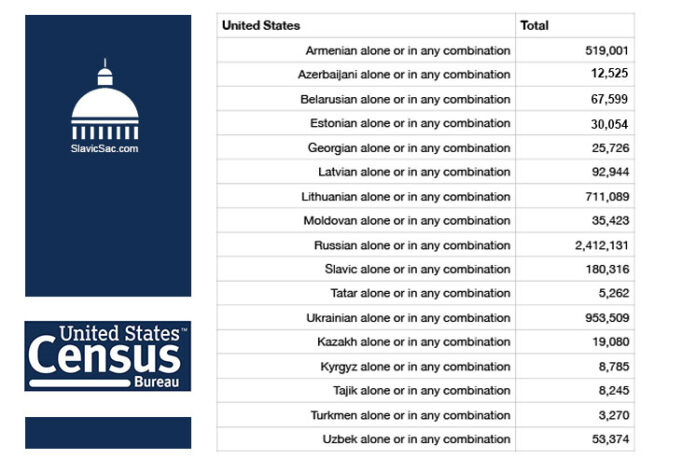Census shows US is home to about 5 million immigrants from post-Soviet countries
According to the latest survey by the United States Census Bureau, about 5 million people from post-Soviet countries currently live in the United States. And that number continues to grow. Recent census data shows the ethnic groups to which these immigrants attribute themselves:
Nationality Number of persons Azerbaijanis 10,321 Armenians 360,166 Belarusians 49,545 Estonians 12,578 Georgians 21,863 Kazakhs 12,877 Kyrgyz 7,036 Latvians 35,853 Lithuanians 174,487 Moldovans 31,458 Russians 984,177 Tatars 2,895 Tajiks 3 507 Turkmens 1,452 Ukrainians 476,106 Uzbeks 30,716 TOTAL: 2 215 037
The U.S. Census Bureau also publishes information about people who consider themselves to be a combination of one or more ethnic groups (for instance, someone born to Ukrainian and Armenian parents). The following numbers indicate people from each ethnic group who consider themselves to be of combined heritage:
Nationality Number of persons Azerbaijanis 12,525 Armenians 519,001 Belarusians 67,599 Estonians 30 054 Georgians 25,726 Kazakhs 19,080 Kyrgyz 8,785 Latvians 92,944 Lithuanians 711,089 Moldovans 35,423 Russians 2,412,131 Tajiks 8 245 Tatars 5,262 Turkmens 3,270 Ukrainians 953,509 Uzbeks 53,375 TOTAL: 4 955 651
If we count all U.S. residents from the former Soviet Union who classify themselves as being of combined heritage, they total 4,901,932 people. In total, there are 132,046,363 Europeans living in the United States who attribute themselves to the combined categories.
Although Census Bureau statistics indicate the number of U.S. residents from the former USSR, that doesn’t mean they migrated directly from these regions. Some of them, before moving to the United States, may have gone first to other countries.
The statistics also do not reflect the number of people who were born in the United States to Russian-speaking families, but who are ethnically related to the Bashkirs, Chukchi or other indigenous groups—including ethnic groups indigenous to Ukraine, Kazakhstan, Moldova and other countries that were part of the former Soviet Union. People from all these groups may have identified themselves as “Russians” when completing the surveys.
Why is census information collected—and how accurate is it?
The U.S. Census Bureau is mandated to collect statistics about the nation, its people and economy. This information helps allocate over $675 billion in federal funds every year. It assists states, local communities and businesses in making informed decisions about such things as where to build and maintain schools, hospitals, transportation infrastructure, and police and fire departments. In addition to the decennial (every ten years) census, the Census Bureau continually conducts over 130 surveys and programs a year.
When conducting surveys, only information provided by the respondents is included. The U.S. Census Bureau does not verify or check the accuracy of statements by participants. (It’s also important to note that the bureau cannot share responses, addresses or personal information with anyone, including the U.S. government, foreign governments, or law enforcement agencies like the IRS, the FBI or Interpol.)
People are encouraged to complete the census form online, but not everybody is technically savvy enough to do this. If the online survey isn’t completed in a few weeks, the Census Bureau automatically mails a paper questionnaire. If census forms still aren’t returned, census workers come to people’s homes to try to get the information. They will make up to six attempts to contact non-respondents. However, there are always a certain number of people who avoid talking to census workers or completing the questionnaires.
The Census Bureau claims a margin of error of ±20 percent for the published numbers. It’s important to remember, however, that the census doesn’t include numbers for undocumented immigrants living in the U.S. According to some media statistics, there are about 12 million undocumented immigrants in the U.S. There is no way to know exactly how many of these are from post-Soviet countries, but the estimated figure reaches up to 500,000. One can only assume that they are trying to avoid communication and interaction with authorities. Immigration lawyers often advise their clients not to tell strangers about their immigration status and to be careful with statements in public. Some of these people may be in limbo and/or subject to deportation. Also, immigrants from post-Soviet countries are not always ready to communicate with governmental agencies. In addition, there are people who live in America as tourists or students for years. All of this may result in a bigger margin of error than ±20 percent.
Where in the U.S. do immigrants from former USSR countries prefer to settle?
The first place, as usual, goes to New York City, with the state of California in second place. However, recent post-Soviet immigrants have tended to leave the Golden State for Texas and North and South Carolina. Illinois is the third most popular place, followed by Pennsylvania and Massachusetts. Of course, post-Soviet immigrants love warm and humid Florida. Washington, D.C., and the state of Maryland are also among their favorite destinations.
After the war began in Ukraine in 2014, the number of Ukrainians in America grew significantly: in 2022, Airbnb alone provided free temporary shelter for 100,000 Ukrainians who arrived in the United States. Residents of Los Angeles, San Francisco and Sacramento have taken and continue to take an active part in supporting Ukrainian migrants crossing the American border through Tijuana, Mexico.
Overall, census data show that the number of citizens coming from former USSR countries keeps increasing. Russians and Ukrainians are the leading ethnic groups, and immigrants from post-Soviet states prefer to settle in big cities on both coasts.
Vitaly Ataev Troshin, SlavicSac.com | California Local News Fellowship
Translation: Elena Kuznetsova, Carma Graber






